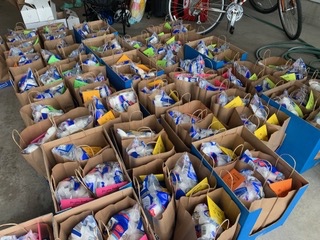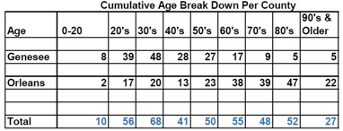Batavia City Council tonight took a step toward changing the municipality’s fund balance policy to give it more muscle and flexibility in dealing with financially stressful circumstances.
Council members agreed to forward a resolution to their June 8 Business Meeting that increases the unassigned fund balance level from 10 percent to a range of 15 to 25 percent of the City’s general fund operating expenditures.
Tonight’s meeting was conducted via Zoom videoconferencing; the June 8 meeting is scheduled to return to the City Hall Council boardroom.
Deputy Director of Finance Lisa Neary, in a memo dated May 18 to City Manager Martin Moore, wrote that she is recommending the revision “in consideration of the current economic situation the City is facing and, in an effort, to create a healthier financial outlook.”
The proposal triggered a 24-minute discussion that touched upon fund balances and reserves as well as restrictions that come with the different types of accounts.
MOORE: TIME HAS COME TO MAKE A CHANGE
“Last August, when we had our financial report we were at approximately 11.3 percent,” Moore said. “Well, we think that it’s time, particularly because of the challenges we’re facing and the impact on the unassigned fund balance, that we need to have an additional amount of unassigned in there to be able to face significant situations.”
Moore said the change is being requested to give the City a lower target to shoot for at 15 percent in unassigned funds but also to have a goal of up to 25 percent in case revenues dried up for several months or if the City faced a “significant challenge” such as a large health insurance claim.
In effect, the move could buy the City some time, with Moore stating that the 10-percent level equates to about five weeks’ worth of unassigned fund balance and that 25 percent moves the bar to three full months.
Neary said the fund balance policy “needs to be a policy that meets our best interests.”
“It seems as though coming into this COVID issue, that 10 percent really doesn’t suit our purposes," she said. "That’s not to say that we’re going to get to 15 or 25 (percent) overnight. We’re going to need a number of good years in order to hit those kind of percentages. But we need at least a policy to do that."
JANKOWSKI: GIVES US A CUSHION
Council President Eugene Jankowski said he thought it was a reasonable request, adding that bumping up the percentage would give the City a cushion if the “market drops or something wild happens like this experience.”
Jankowski mentioned that Council previously budgeted to put money into reserves, but, in light of what has transpired with the coronavirus, it would act differently now.
“Maybe we didn’t want to put that money into reserves because we needed it for everyday operating expenses,” he said. “There really is no mechanism for us to pull money out of reserve and say, ‘never mind we’re going to not use it for reserve, we’re going to put it over here.’ The reserves are reserves because they’re protected; they’re locked (for specific purposes) for a reason.”
Moore said that a conversation is taking place with local and state leaders about reserve fund options and that he plans to reach out to Assemblyman Steve Hawley and Sen. Michael Ranzenhofer “to allow us to deal with operating expenses and give us a reasonable time to be able to repay the reserve.”
VAN NEST: RESTRICTIONS ABOUND
City Attorney George Van Nest said the problem with reserve funds under Article 6 of the General Municipal Law is that each type of reserve fund is very restrictive as to what it can be used for, and if there’s any leftover balance as to how that can be used.
“When you get into a financial situation like this, you just don’t have the statutory flexibility that you’d hope for or want to be able to access some of those funds …,” he said.
Van Nest then mentioned a bill in the State Assembly (A10492) relating to bond anticipation notes issued from 2015 to 2021 that authorizes the expenditure and temporary transfer of reserve funds for expenses related to COVID-19, and gives an extension of repayment of interfund advances made for expenses related to COVID-19.
“This legislation is something that NYCOM (New York Conference of Mayors) has obviously been supporting on behalf of municipal members and something that they are tracking very closely,” he said.
Council Member John Canale asked Van Nest if the board would be able to “borrow our own money … and then pay that fund back?”
Van Nest said that a capital reserve fund could only be used for capital expenditures and that a transfer from any type of reserve could be used for COVID-related issues as long as it is repaid, with interest, within a five-year period.
Jankowski said he puts a lot of stock in reserve funding for specific projects, but it’s not a priority at the moment.
“If we would have known in January when we were doing our budget that we were going to take a hit, I don’t think any of us would have put any money into reserves,” he said. “We would have said let’s hold off in reserves this year and keep the money in our fund balance or in our fund, not in reserves, in the event we go short somewhere, then we have the money.”
NEARY: RESCINDING MAY BE AN OPTION
Neary said that she believes that Council has the power to rescind a prior authorization to fund reserves in the 2020-21 budget, leading Van Nest to say that he would look into such a measure.
Canale wrapped things up by saying he wanted to know “for a fact what our options would be.”
“It’s about being prepared for the worst,” he said. “And I think at this point we really need to. I’m doing it on a personal level as well. I’m preparing for the worst and making sure that I have funds available if I need to during a second wave of this thing.”
In other action, Council approved a resolution amending the City’s investment policy to add BankonBuffalo (formerly Bank of Akron) as a designated depository. The resolution was immediately forwarded from the Conference Meeting to a Special Business Meeting set up tonight exclusively for this item.
In explaining the reasoning for the move, Moore said that the City has a chance to get a “more favorable” interest rate of around .75 percent from BankonBuffalo by investing liquid funds that aren’t immediately needed but could be accessed if necessary.
City Clerk Heidi Parker said the resolution was expedited to get BankonBuffalo “in there so we can move quickly in investing this money.”
Future policy changes would allow investments to be made without having to wait “for a Council meeting to come up in case it is a bank that is not listed as one of our designated depositories,” she said.
Jankowski said he had no problem with the resolution, but asked for additional modifications in the wording of the policy that included “some kind of checks and balances” to make sure that more than one person is involved in the process.
He suggested that Parker, Moore, Neary and Assistant Manager Rachael Tabelski all have a say in these types of investments and the financial institutions to be utilized.
Also, as previously reported on The Batavian, Council moved to the June 8 meeting a resolution that spells out a $554,112 grant the City received from the NYS Department of Health’s Lead Service Line Replacement Plan.
The grant will enable City crews to replace up to 75 lead service lines on Swan, Hutchins and Otis streets on the City’s Southside.
DPW Director Matt Worth said the grant requires no match from the City and the only cost a homeowner would incur is if crews were unable to make a connection from the curb shut-off into the house likely due to a deteriorating pipeline.
(Click here to see the previous story.)
Another resolution forwarded to the June 8 meeting was a motion to obtain a firm to provide administration/engineering services for a $750,000 Downtown Revitalization Initiative project to improve Jackson Square.
Worth said the deadline for firms to respond to the City’s request for quotation is Wednesday.
He also reported that the City Centre mall roof replacement project is about 35 to 40 percent complete and he expects it to be done within 30 days.
“Hopefully, the buckets will be gone by the end of June,” Jankowski quipped.






